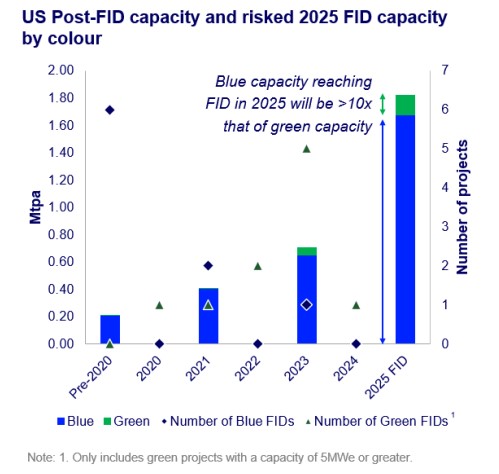The pace for the low-carbon-hydrogen and ammonia sectors is set to pick up in 2025, with key themes to watch for including the rise of blue hydrogen in the U.S., a
The pace for the low-carbon-hydrogen and ammonia sectors is set to pick up in 2025, with key themes to watch for including the rise of blue hydrogen in the U.S., a giga-scale green project reaching final investment decision (FID), increased deployment of Chinese electrolyzers, the persistent mismatch between project FIDs and offtake contracts and a surge in low-carbon ammonia investments, according to data and analytics solutions provider Wood Mackenzie (WoodMac).

In a new report, ‘The Hydrogen: 5 things to look for in 2025,’ the provider forecasted that the U.S. will consolidate its position as a blue-focused hydrogen market, driven by policy developments under a second Trump administration. Allegedly, more than 1.5 mtpa of U.S. blue hydrogen capacity will reach FID in 2025, which is at least ten times more than green.
“We predict that the 45Q tax credit will remain in place due to strong support from the oil and gas lobby, and its importance in facilitating US exports of blue ammonia. As a result, we predict that a surge in blue hydrogen investment – with at least three large-scale blue hydrogen projects reaching FID – will see the US emerge as the world’s leading blue hydrogen producer. On the other hand, we predict that green hydrogen development will face significant headwinds in 2025, with FIDs continuing to disappoint,” Greig Boulstridge, Research Analyst at WoodMac, stated.
As reported, to date, 16 GWe of green capacity has reached FID, but only two of these projects are larger than 1 GWe. However, despite the challenges, at least one giga-scale green project is expected to take FID in 2025
“The path to successful large-scale FIDs is not straightforward. Key factors such as securing offtakers, access to renewable energy, favourable regulatory environments, and government subsidies are critical for projects to move forward,” Monica Trilho, Research Analyst at WoodMac, remarked.
“Despite the challenges, we anticipate the continued push of giga-scale green hydrogen projects. Over 150 projects have been proposed with +1GWe, but the majority are longer-term or unlikely to materialize. However, we do anticipate at least one more giga-scale FID expected to be announced in 2025.”
Regarding the electrolyzer market, the report said that Chinese electrolyzer manufacturers will begin to increase competition in other regions of the globe.
WoodMac predicted that outside of North America and Europe, market penetration of Chinese equipment will exceed one-third by the end of 2025. This expectation is based on several factors, including the increasing demand for green hydrogen and the competitive edge that Chinese electrolyzers offer in terms of cost, manufacturing capacity and shorter delivery times.
Another key thing to watch for in 2025 is the persistence of a mismatch between project FIDs and offtake contracts. As per WoodMac, many FIDs have been initiated despite offtake contracts in place, risking cancellations and straining developer pipelines. Acceleration of offtake agreements in Japan, South Korea and Europe could reduce the gap in 2025, the data provider noted, adding that currently, uncontracted FID volume is more than 2.5 mpta, with the U.S. accounting for a majority.
“Although some current uncontracted capacity may unwind, overall uncontracted volumes are expected to edge up, driven by anticipated FIDs for blue hydrogen projects,”Danish Sunasra, Research Associate at WoodMac, pointed out.
Finally, the data provider predicted a surge in low-carbon ammonia investments. Reportedly, with Japanese firms leading the way, 2025 is poised to be a bigger year than 2024, with $8 billion in projected deals.
“Upstream, we expect US$ 5 billion in investment as companies, including NOCs, renewable energy champions, and large investment funds, continue to expand their portfolios. Many of these investors are targeting new energy markets for hydrogen (e.g. maritime, aviation, etc.), where demand for low-carbon ammonia is rising, positioning themselves to secure long-term offtake agreements as the market scales,” Thomas Pellegrinelli, Senior Research Analyst at WoodMac, said.
Meanwhile, downstream, $2 billion is expected to be directed toward ammonia storage terminals, while $1 billion is predicted to flow into large ammonia carriers, ensuring developers can meet rising demand in export markets like Asia and Europe.
READ MORE
Content Original Link:
" target="_blank">


























































